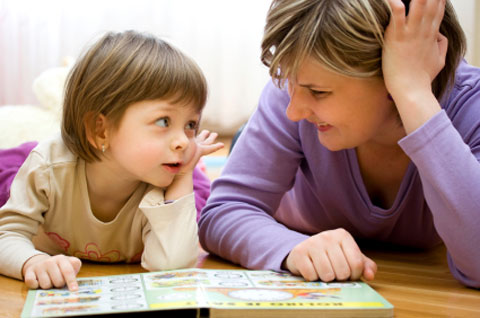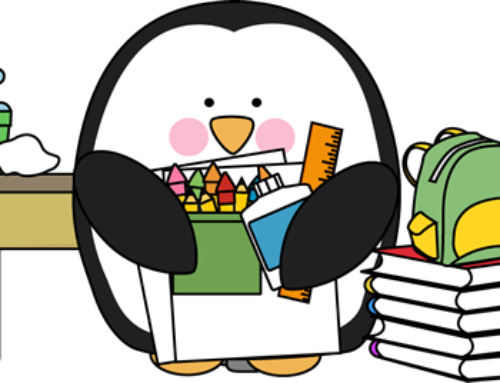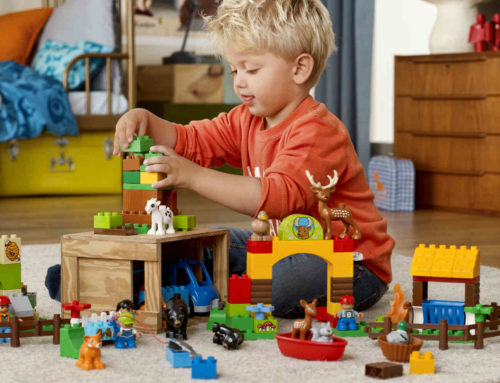When learning any new skill, whether it’s how to tie shoelaces or drive a car, practice makes perfect!
A child learning their speech sounds is no exception. When children first start to talk, lots of what they say is unclear and hard (or virtually impossible) to understand. As they get older and talk more and more, their speech becomes clearer. By the time they are ready to start school, they should be clear enough for anyone to understand.
You can read our previous post on normal patterns of speech sound development here.
Sometimes, for many different reasons, speech sound errors persist and speech therapy is recommended. The type of therapy that is used will depend on many factors including the child’s age and personality as well as the type and severity of their speech sound disorder. However, one fact remains the same… they will only improve with practice, practice and more practice!
The speech pathologist will talk to you about what sounds and words your child needs to work on. This is important. We are not just making up random lists of words. We have selected sounds and words that best suit your child’s level – they need to be challenging, but not so hard that your child will not have success. Generally speaking, once a child is independently achieving 80% accuracy at one level, we can move them up to the next. To do this, they need to practice for at least 5 -10 minutes everyday!
Some children need to start right at the beginning and practice a speech sound in isolation such as “s”, then work up to producing that sound plus a vowel (e.g. “sa”, “se”, “su”, “os”, “iss”, “us”) and then words with that sound in different positions within the word (e.g., sun, listen bus).
Let’s face it, asking your child to say “s” over and over again gets old quickly. Before you know it there is shouting, tears, maybe even bribes and threats and that’s not going to help anybody. We want to keep it fun and motivating but parents often think that means using new toys and games, or at least the same games and resources that the speech pathologist uses. In actual fact, you probably already have lots of toys and games at home that would be fantastic to use. Remember, repetition is the key. There’s no point playing a game in which your child will say the target sound or word once. The more times they get to say it the better. Here are 10 examples of popular games and toys that can be used to practice speech sounds…
1. Connect 4
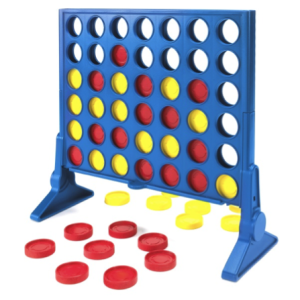
Throw the rule book aside and tell your child you just want them to put all the tokens in as quickly as they can to make a pattern. The catch… to get a token they need to say the target sound or word. Think about it, that’s 42 opportunities for your child to say the target sound in just a few minutes!
2. Bowling
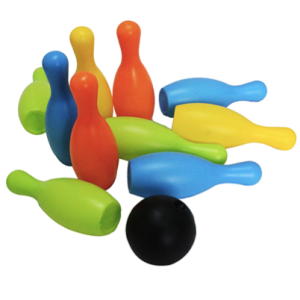
Choose a target sound or word first and then let your child have their turn. The number of pins they knock down will be the number of times they need to repeat the sound/word. Set the pins up again and choose a different target word and continue until all the words have been practiced. Otherwise, write some of the target sounds/words onto a post-it and stick them onto each pin. Your child will then need to name the ones they have knocked over after each turn.
3. Mr Potato Head
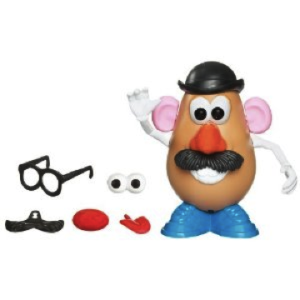
Put all of Mr Potato Head’s pieces into a small bag or box. Ask your child to say their target sound or word 5 times and then let them put their hand into the bag or box to choose a piece. Continue until they have put Mr Potato Head together (or made their version of him anyway).
4. Marble Maze
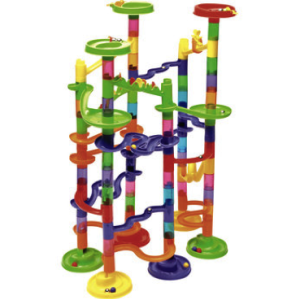
Depending on how patient you are, you could ask your child to say their target sound or word 5 times and then give them a few pieces of the maze to put together (but hold onto the marbles until the very end). You could repeat this step over and over, changing the target sound or word where necessary, but be prepared for this to take a while! This is a great activity to do together if you have time, otherwise you could wait for your child to build the maze themselves and then give them a marble each time they have successfully said the target word or sound 5 times.
5. Bubbles

Speech sound practice doesn’t have to take place sitting inside at the table. Why not go outside, burn off some energy and get some fresh air all at the same time? I have yet to meet a child who doesn’t like bubbles so this game is often a popular one, especially with younger children. Get your child to say a target sound or word 5 times and then blow some bubbles. Let them run around chasing and popping the bubbles until they have all gone. Then get them to say another target sound or word, and blow more bubbles. Just keep repeating these steps for as long as they are enjoying it. If the child wants to blow the bubbles themselves, make sure you take the stick off them each time and give it back once they have said the target sound.
6. Train set
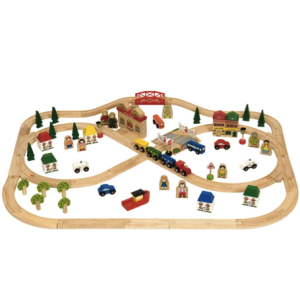
Help your child put together a track and as they are driving the train around, gently pull one of the pieces out (preferably one they are about the cross). To fix the track they’ll need to say the magic word! Once they have said the target sound or word 5 times, replace the piece and let them continue playing for a minute, then remove a different piece of the track and ask them to say another target sound or word 5 times.
7. Puzzles
Write the target words onto small pieces of paper (or photocopy and cut up the pictures your speech therapist has provided) and cover them with the jumbled up puzzle pieces. Ask your child to put the puzzle together. As they choose pieces, the pictures or words underneath will become visible. Get them to name the words or pictures as they are uncovered and repeat it 5 times before choosing the next piece of the puzzle.
8. Posting
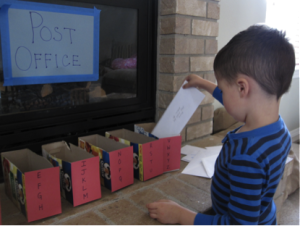
Set up some containers or boxes around the room as letter boxes. Draw pictures or write some target words onto pieces of paper and place them all in a bag. Ask your child to be the postman and to pick a “letter” out of the bag. They need to say the target word or sound they have chosen 5 times and then go and “deliver” the letter to one of the boxes around the room. When they have finished, they can come back and select the next letter from the bag and play continues.
9. Ball Toss
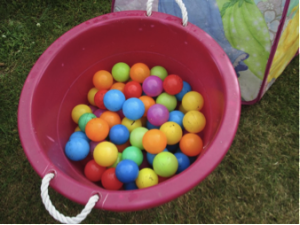
Get a bucket, box or laundry basket and something your kids can throw into it. If you’ve got some small plastic balls such as those found in ball pits, they are great for this game, otherwise you could use tennis balls, or even soft toys. Ask your child to take 6-8 steps back from the bucket then give them a target word or sound to say. Tell them that they get 5 chances to say the sound or word, and each time they say it accurately they get to take a step forward. After they have had 5 attempts (and are hopefully 5 steps closer to the bucket) they get to try and throw the ball in. You can award points for every toy that lands in the bucket and come up with a prize if they score 10 points etc.
10. Pop up pirate
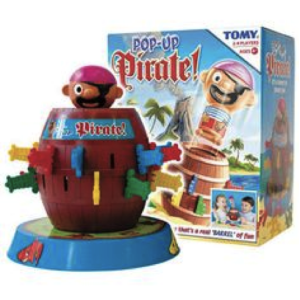
This game is a go-to for all the speech pathologists that I know because the kids absolutely love it! You put the pirate into the barrel and then stick the plastic swords in until he pops out. Choose a target word or sound and get your child to say it before putting a sword into the barrel. You can continue to practice the same target word or sound until the pirate pops, or you can limit it to 5 times and then choose another word. This game is quick and easy and lots of fun.
So there you have it…
Hopefully you’ve gone through the list and come across a few items that you already have lying around at home. If not, try to think outside the box. For example, you could use almost any board game to practice speech sounds if you ignore the rules. Instead, simply roll the dice and whatever comes up is the number of times your child has to say the target word before they make their move, collect the token, have their turn etc. Use anything that you think will work and don’t worry if it doesn’t. There’s always next time.
A final few tips to remember:
Repetition is the key, so it’s best if the game suits a stop-start sort of pattern so that you get more opportunities to practice.
Speech sounds must be the focus – You want your child to be having fun but they ultimately need to be thinking about and focusing on their speech sounds. For this reason I tend to steer clear of games like memory, or Guess Who because they require the child to be thinking about the game (e.g. remembering where things are, or what questions they have asked previously) which takes their focus away from their speech.
Practice all the sounds/words – Don’t give your child total control in selecting which target sounds or words to say because they will pick the easiest ones and just keep doing them. Make sure you get them to have a go at all of the words.
Above all, stay positive, keep encouraging your child and of course if you have any questions or concerns talk to your speech pathologist! We’re here to help!
Remember… Sharing is caring. You can also like our Facebook page for more.

